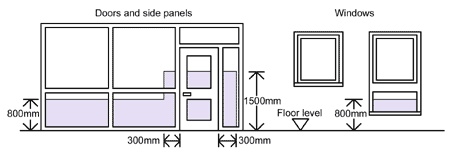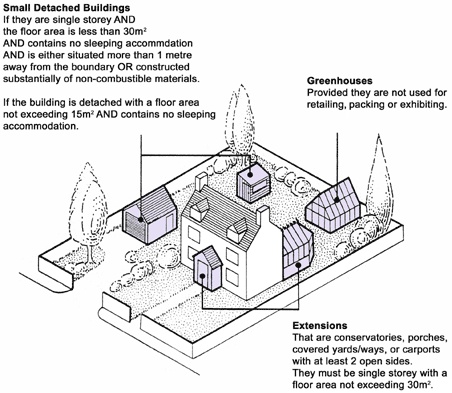
Building
houses, extensions, conversions, internal alterations, local authority planning
consent, building regulations consent & all other building matters.
Please use our carefully
selected featured links below to obtain information & quotes for all
types of residential building. This Article is FREE for anyone to
use.

TOPICAL
CONTENT......
Quick
links to our BUILDING guide
-
Building control - exempt buildings
Planning
control - permitted development works

Building Control
- Exempt Buildings
Some buildings and
extensions are exempt from the Building Regulations. These include small
garden sheds, detached garages, conservatories and porches. In all cases
certain restrictions on size, use or construction apply.
The following information
has been provided to help you decide if your building works are exempt.
Most Building Control Departments will have an 'Exempt Buildings Form'
which lists those works which are entirely exempt. The completion and return
of this form will allow the Council to provide you with written confirmation
that your proposed building work is exempt or not . There is no requirement
to submit this form, however, our experience has shown that written confirmation
that works are exempt can be useful and save time when the property is being
sold. Please note that Planning Permission may also be required for your
proposed building work. Therefore you are advised to contact the Development
Control Section to seek their comments.
Glazing for
Conservatories and Porches Any glazing shown in the shaded areas of the
diagram below needs to comply with Approved Document N of the Building
Regulations 1992, for the proposals to be considered exempt.

Types of Exempt
Building Work Certain buildings and extensions are granted complete exemption
from the Building Regulations, these are listed below:
Class I - Buildings
controlled under other legislation. eg. Ancient Monuments and Nuclear power
stations.
Class II - Buildings not frequented by people. eg. Detached building housing
plant, only visited for maintenance.
Class III - Greenhouses and agricultural buildings. Greenhouses provided
they are not used for retailing, packing or exhibiting. Agricultural buildings,
eg. a barn used solely for keeping animals. Class IV - Temporary buildings.
eg. a marquee erected for a show or exhibition.
Class V - Ancillary buildings. eg. huts on a construction site.
Class VI - Small detached buildings. See diagram below.
Class VII - Extensions. See diagram below. In addition to this, other criteria
is applicable to conservatories and porches.

Building Control
- Policy Note 3/02 Criteria for an extension, used as a conservatory,
being exempt from the Building Regulations - [Schedule 2, Exempt Buildings
and Work, Class VII (a)] Background: Over recent years the public perception
of what can be termed a conservatory has changed. The Oxford Dictionary (1990)
defines a conservatory as "a greenhouse for tender plants " and in particular
"one attached to and communicating with a house". The Building Regulations,
Approved Document L1, Section 1 (1.58) states that "a conservatory has not
less than three quarters of the area of its roof and not less than one half
of the area of its external walls made of translucent material" Since
conservatories became exempt under the 1985 Building Regulations manufacturers
have exploited this exemption by promoting them for such uses as breakfast,
dining and sitting rooms: effectively they are seen as an extension to living
accommodation.
WHY
NOT OBTAIN OUR MAXIMUM BUILD PLANNING
GUIDE
 New simple to understand
Planning Guide... "Puts dozens of strategies & risk assessments procedures
that you should be completing BEFORE you present a scheme for formal Planning
Approval in the UK." (Order your 'ebook' today & find out how the
'Professional Planning Consultant' prepares a scheme for residential development
PRIOR to formally submitting an extension scheme or full site redevelopment
to the Planners!). New simple to understand
Planning Guide... "Puts dozens of strategies & risk assessments procedures
that you should be completing BEFORE you present a scheme for formal Planning
Approval in the UK." (Order your 'ebook' today & find out how the
'Professional Planning Consultant' prepares a scheme for residential development
PRIOR to formally submitting an extension scheme or full site redevelopment
to the Planners!).
 Obtaining Planning Permission
for residential development in either extending your property or redeveloping
the site for new dwellings needs careful presentation & a risk assessment
prior to submitting for Planning Consent. A badly presented scheme to the
Planning Department by the Novice home owner can lead to an Automatic Rejection
& a Planning Refusal that could be hard to overturn. Our MAXIMUM BUILD
Guide will assist you in assessing your sites potential & what areas
you can exploit prior to submitting your scheme for Planning
Permission. Obtaining Planning Permission
for residential development in either extending your property or redeveloping
the site for new dwellings needs careful presentation & a risk assessment
prior to submitting for Planning Consent. A badly presented scheme to the
Planning Department by the Novice home owner can lead to an Automatic Rejection
& a Planning Refusal that could be hard to overturn. Our MAXIMUM BUILD
Guide will assist you in assessing your sites potential & what areas
you can exploit prior to submitting your scheme for Planning
Permission.
 click here
to find out more about our guide click here
to find out more about our guide |
Policy: To
be considered exempt, an extension to a building for use as a conservatory
shall be: At ground level and not exceed 30m2 floor area. Glazed to satisfy
the requirements of Part N of Schedule 1. Physically separated internally
from the building it is attached to, e.g. by a door. Without sanitary appliances.
Provided with separate temperature and on/off controls on any fixed heating.
Not intended for year round habitable use. Used to some extent for the
propagation of plants. Note: All other extensions used as a conservatory
are fully controlled under the Building Regulations, as are all conservatories
erected in conjunction with a new build house.
Building Control
- Policy Note 4/02 Criteria for an extension, used as a porch, being
exempt from the Building Regulation - [Schedule 2, Exempt Buildings and Work,
Class VII (a)]. Background: Since porches became exempt under the 1985 Building
Regulations owners and developers have exploited this to cover a wide range
of extensions. The Oxford Dictionary 1990 defines a porch as "a low structure
projecting from the doorway of a house and forming a covered entrance". Policy:
To be considered exempt, an extension to a building for use as a porch shall
be: At ground level and not exceed 30m2 floor area. Glazed to satisfy the
requirements of Part N of Schedule 1. Positioned over and physically separated
from the building it is attached to by a door. Without sanitary appliances.
Provided with separate temperature and on/off controls on any fixed
heating.
 Development Control - PLANNING Development Control - PLANNING
Planning advice -
what you can and cannot do:
Domestic Alterations,
Extensions and alterations, Roof extensions, Swimming Pools, Garages, Garden
Sheds, Greenhouses, Porches, Containers, Hardstanding, Gates, Fences, Walls,
Satellite antenna, Painting.
All of the above
works can to some degree be completed without the need to obtain a specific
Planning Approval. This is called Permitted Development. However, like
most government legislation it is riddled with catches & restrictions
so you must always check first as your site might have specific conditions
that do not allow the implementation of your permitted development rights.
Applications for
planning permission to carry out domestic work constitute the largest single
category of applications dealt with by most Councils (approximately 40% of
the total).The following summary provides general guidance on a number of
minor domestic works which may normally be undertaken without the need for
an application for planning permission. However, professional advice should
always be sought before carrying out works, because the regulations themselves
are complex. Particular care must be taken if the house is a listed building,
is within a conservation area, or affected by an Article 4 Direction, or
is in an Area of Outstanding Natural Beauty (AONB).
NEXT
STEP - THE BUILDING REGULATIONS - OBTAINING BUILDING CONTROL
APPROVAL
 To compliment our Planning
Guide we have also produced a UK specific Specification Manual solely aimed
at the domestic/residential side of building. Are you completing your
own drawing plans for the Building Regulations as well? Why not obtain our
'Specification Manual' to assist you with obtaining Building Regulations
Approval as well. Alternatively you may have already secured Planning
Approval & just need this document. To compliment our Planning
Guide we have also produced a UK specific Specification Manual solely aimed
at the domestic/residential side of building. Are you completing your
own drawing plans for the Building Regulations as well? Why not obtain our
'Specification Manual' to assist you with obtaining Building Regulations
Approval as well. Alternatively you may have already secured Planning
Approval & just need this document.
 click
here to find out more about our Specification
Manual click
here to find out more about our Specification
Manual |
(1) Extensions
or other alterations provided that:
(a) measured around
the outside, the extension is less than 70 cubic metres or 15%* of the volume
of the original house, whichever is the greater. If the house is in a terrace,
or a conservation area or an AONB, the limit is 50 cubic metres or 10%*.
If the house has been extended before, the volume of this must be added to
the new work and, together, be less than the limit;* In these cases, an overall
maximum of 115 metres applies.
(b) any extension
does not project above the highest part of the roof of the original
house;
(c) no part of the
extension is within 20 metres of any highway**. However, if the original
house is less than 20 metres from a highway, any extension must not be nearer
the highway than the original house;
(d) no part of any
extension, within 2 metres of a boundary, is more than 4 metres
high;
(e) the total area
of such building does not exceed one half of the garden area;
(f) within a conservation
area or AONB, no cladding of any part of the exterior with stone, artificial
stone, timber, plastic or tiles, is carried out.** A footpath may be a highway
for the purposes of this provision.
(2) Roof extensions
provided that:
(a) any extension
does not exceed the highest part of the existing roof;
(b) any extension
does not extend beyond an existing roof slope which fronts a highway**;**
A footpath may be a highway for the purposes of this provision.
(c) the cubic content
of the house is not increased by more than 40m3, in the case of a terraced
house, or 50m3 in any other case;
(d) as with other
extensions, the cubic content of the original house must not be increased
beyond the limits set out in item
(1)(a). If the house
has been extended before, the volume of this must be added to the roof extension
and together be less than the relevant limit;(e) the house is not in a
conservation area or an AONB.
(3) Swimming pools,
garages***, garden sheds, greenhouses, etc, required for domestic purposes
provided that:
(a) any
development is not within 20 metres of a highway**. If the original house
is less than 20 metres from a highway, any development must not be nearer
the highway than the original house;
(b) any building
greater than 10 cubic metres is not within 5 metres of the house. Such buildings
may sometimes be treated as extensions and fall within (1)
above;
(c) in the case of
a ridged roof, its height does not exceed 4 metres and, in any other case,
3 metres;
(d) any building
is not greater than 10 cubic metres, if the house is listed or if it is in
a conservation area or an AONB;
(e) the total area
of any development does not exceed half of the garden area of the house.***
An application for planning permission may be needed to form or alter an
access to a highway, particularly if it is a classified
road.
(4) Porches provided
that:
(a) their floor area
does not exceed 3 square metres;(b) they are not more than 3 metres high;(c)
they are not within 2 metres of any highway**.** A footpath may be a highway
for the purposes of this provision.
(5) Containers
for storage of oil for domestic heating provided that:
(a) their capacity
is not more than 3,500 litres;(b) they are not more than 3 metres above
ground;(c) they are at least 20 metres from the highway or, if the original
house is less than 20 metres from the highway, not closer to the highway
than the original house**.
(6) Hardstanding***
within the garden of a house for domestic purposes eg a patio or a car parking
space.*** An application for planning permission may be needed to form
or alter an access to a highway, particularly if it is a classified
road.
(7) Gates, fences
or walls provided that:
(a) they do not exceed
1 metre in height adjacent to a highway used by vehicles, or 2 metres
elsewhere;
(b) they do not exceed
the height of any existing gate, fence or wall if these are greater than
the heights referred to in (a);
(c) the house is
not listed.
(8) A satellite
antenna provided that:
(a) it does
not exceed 90cm in any dimension, or 45cm if installed on a
chimney;
(b) there is no other
satellite antenna on the house or within the garden;
(c) it is not higher
than the highest part of the roof, or the highest part of the chimney if
installed on a chimney; Note: Special restrictions apply in conservation
areas and AONB’s. In all cases an antenna must be sited to minimise
its effect on the external appearance.
(9) The painting
of the exterior provided that:
(a) it is not for
the purpose of advertisement, announcement or direction.* In these cases,
an overall maximum of 115 metres applies. ** A footpath may be a highway
for the purposes of this provision. *** An application for planning permission
may be needed to form or alter an access to a highway, particularly if it
is a classified road.


|